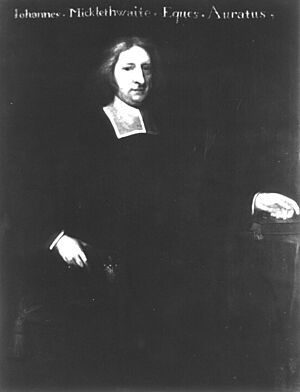John Micklethwaite facts for kids
Sir John Micklethwaite (born 1612, died 1682) was an important English doctor. He was even the personal physician to King Charles II. He also led the Royal College of Physicians, a famous group of doctors.
Contents
The Life of Sir John Micklethwaite
John Micklethwaite was born in 1612 in Yorkshire, England. His father, Thomas Micklethwaite, was a church leader. John was baptized on August 23, 1612, in a church near Beverley.
Becoming a Doctor
John Micklethwaite wanted to be a doctor. He began studying medicine in 1637 at the University of Leyden. This university was in the Netherlands. In 1638, he earned his M.D. degree from the University of Padua in Italy. An M.D. degree means "Doctor of Medicine." It shows he was fully qualified to practice medicine. Later, in 1648, he also got an M.D. degree from Oxford University in England.
Working at St. Bartholomew's Hospital
In 1643, John Micklethwaite started working at St. Bartholomew's Hospital. This was a well-known hospital in London. He began as an assistant doctor. He later married the daughter of Dr. John Clarke, another doctor at the hospital. By 1653, he became a full physician at the hospital.
Leading the Royal College of Physicians
John Micklethwaite became a member of the Royal College of Physicians in 1643. This college was a very important group for doctors in England. He gave special lectures there in 1644. He was chosen to be a "censor" seven times. A censor helped make sure doctors followed the rules. From 1667 to 1675, he was the treasurer. Then, from 1676 to 1681, he became the President of the College. This was a very high honor.
Doctor to the King
In 1681, King Charles II became very sick. The King was staying at Windsor Castle. Sir John Micklethwaite was called to help him. He treated the King, and King Charles II got better. Because of his excellent care, the King made him a knight. This meant he was called "Sir John Micklethwaite." He also became the King's personal doctor.
Sir John Micklethwaite died on July 29, 1682. He was buried in a church in London. A monument was placed there to remember him. His portrait, showing him with a long wig, was given to the Royal College of Physicians. It still hangs there today.


